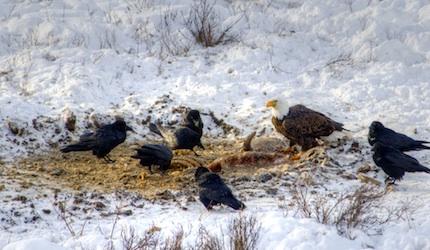The National Park Service likes to emphasize that it strives to let natural processes play out in the parks, but there are times when rangers must intervene and take an active role in that process. That happened recently in Yellowstone National Park, where rangers killed an elk and bison that were in distress.
In the case of the elk, which floundered on a road, rangers shot and killed the animal and had it hauled away. In the case of the bison, which struggled for hours to climb out of one of the Blacktail ponds, the rangers killed the bull and hauled it onto the ground for scavengers to devour.
"In the past week we had to euthanize both a bull elk and a bull bison in roughly the same area of the park near Blacktail. The elk was a sickly older male who would not leave the road surface at the Lava Creek trailhead/picnic area," park spokesman Dan Hottle said Friday. "We made repeated attempts to usher him from the road and pullout area, but he would lie down in the road, so we removed him after exhausting all of our other efforts.
"The bull bison had fallen through some ice near the shore of one of the Blacktail ponds just a few days later. He, too, was an old one, sickly and could not get himself out of the boggy area that surrounds the ponds," the spokesman related in an email. "We have had quite a few bison get stuck there over the years. It's a popular watering hole, but with sketchy, soft soil and marsh around it that they have trouble navigating now and then. So we made the decision to put that animal down as well."
According to Mr. Hottle, rangers don't often resort to putting down an animal in the park, but it happens. In October 2011, for instance, a wolf that repeatedly approached visitors looking for food was put down. Earlier that same month a grizzly sow linked to the fatal maulings in the park was tracked and killed by rangers.
"In regards to euthanization, we evaluate each case separately," said Mr. Hottle when asked about the Park Service's "natural processes" policy. "There's no 'standard,' obviously. We look foremost at the need to be humane for the animal if it is simply in imminent grave condition, whether injured by car, or attacked by a predator, etc. We also look at the animal's proximity to the road and heavily-traveled public access areas.
"In both (recent) cases these animals were dying right by the only vehicle pullouts in both areas. A carcass usually attracts predators very quickly, and the ensuing vehicle jam with wildlife spotters and onlookers, even in the winter. So we have to evaluate both the condition of the animal and all public safety aspects. Outside of those conditions, yes, we would allow natural processes to occur always."
While Yellowstone rangers file a report when they put down an animal, during the "quiet week" between Christmas and New Years a specific list of all such incidents in 2012 could not be compiled, according to the park spokesman. But he estimated that it was no more than three to five times a year.




Add comment